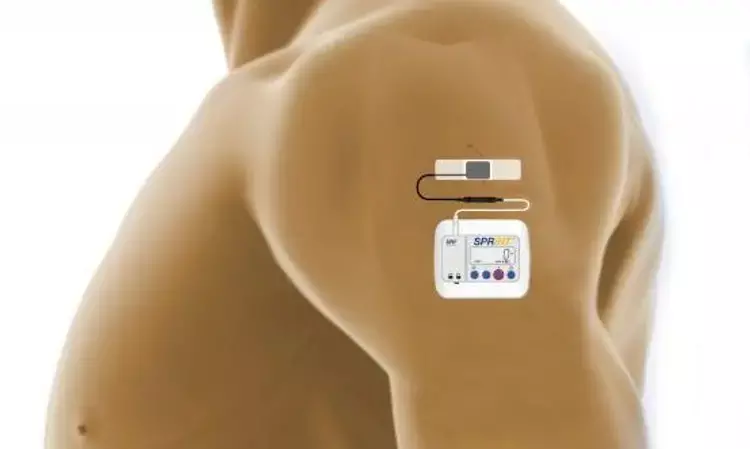- Home
- Medical news & Guidelines
- Anesthesiology
- Cardiology and CTVS
- Critical Care
- Dentistry
- Dermatology
- Diabetes and Endocrinology
- ENT
- Gastroenterology
- Medicine
- Nephrology
- Neurology
- Obstretics-Gynaecology
- Oncology
- Ophthalmology
- Orthopaedics
- Pediatrics-Neonatology
- Psychiatry
- Pulmonology
- Radiology
- Surgery
- Urology
- Laboratory Medicine
- Diet
- Nursing
- Paramedical
- Physiotherapy
- Health news
- Fact Check
- Bone Health Fact Check
- Brain Health Fact Check
- Cancer Related Fact Check
- Child Care Fact Check
- Dental and oral health fact check
- Diabetes and metabolic health fact check
- Diet and Nutrition Fact Check
- Eye and ENT Care Fact Check
- Fitness fact check
- Gut health fact check
- Heart health fact check
- Kidney health fact check
- Medical education fact check
- Men's health fact check
- Respiratory fact check
- Skin and hair care fact check
- Vaccine and Immunization fact check
- Women's health fact check
- AYUSH
- State News
- Andaman and Nicobar Islands
- Andhra Pradesh
- Arunachal Pradesh
- Assam
- Bihar
- Chandigarh
- Chattisgarh
- Dadra and Nagar Haveli
- Daman and Diu
- Delhi
- Goa
- Gujarat
- Haryana
- Himachal Pradesh
- Jammu & Kashmir
- Jharkhand
- Karnataka
- Kerala
- Ladakh
- Lakshadweep
- Madhya Pradesh
- Maharashtra
- Manipur
- Meghalaya
- Mizoram
- Nagaland
- Odisha
- Puducherry
- Punjab
- Rajasthan
- Sikkim
- Tamil Nadu
- Telangana
- Tripura
- Uttar Pradesh
- Uttrakhand
- West Bengal
- Medical Education
- Industry
Percutaneous peripheral nerve stimulation lowers pain scores after orthopedic surgery: Study

According to recent research reports, percutaneous peripheral nerve stimulation reduced pain scores and opioid requirements free of systemic side effects during at least the initial week after ambulatory orthopedic surgery. The findings have been published in Anesthesiology.
Percutaneous peripheral nerve stimulation is an analgesic technique involving the percutaneous implantation of a lead followed by the delivery of electric current using an external pulse generator. Percutaneous peripheral nerve stimulation has been used extensively for chronic pain, but only uncontrolled series have been published for acute postoperative pain. The current multicenter study was undertaken to (1) determine the feasibility and optimize the protocol for a subsequent clinical trial and (2) estimate the treatment effect of percutaneous peripheral nerve stimulation on postoperative pain and opioid consumption.
Preoperatively, an electrical lead was percutaneously implanted to target the sciatic nerve for major foot/ankle surgery (e.g., hallux valgus correction), the femoral nerve for anterior cruciate ligament reconstruction, or the brachial plexus for rotator cuff repair, followed by a single injection of long-acting local anesthetic along the same nerve/plexus. Postoperatively, participants were randomized to 14 days of either electrical stimulation (n = 32) or sham stimulation (n = 34) using an external pulse generator in a double-masked fashion.
The dual primary treatment effect outcome measures were (1) cumulative opioid consumption (in oral morphine equivalents) and (2) mean values of the "average" daily pain scores measured on the 0 to 10 Numeric Rating Scale within the first 7 postoperative days.
Results put forth some key facts.
- During the first 7 postoperative days, opioid consumption in participants given active stimulation was a median (interquartile range) of 5 mg (0 to 30) versus 48 mg (25 to 90) in patients given sham treatment (ratio of geometric means, 0.20 [97.5% CI, 0.07 to 0.57]; P < 0.001).
- During this same period, the average pain intensity in patients given active stimulation was a mean ± SD of 1.1 ± 1.1 versus 3.1 ± 1.7 in those given sham (difference, −1.8 [97.5% CI, −2.6 to −0.9]; P < 0.001).
"The use of active versus sham percutaneous peripheral nerve stimulation was associated with a reduction in pain scores and opioid consumption in the first 7 days after upper and lower extremity surgery.Peripheral nerve stimulation may also reduce pain's interference with physical and emotional functioning with few side effects."the research team concluded.
For full article follow the link: https://doi.org/10.1097/ALN.0000000000003776
Source: Anesthesiology
Dr Satabdi Saha (BDS, MDS) is a practicing pediatric dentist with a keen interest in new medical researches and updates. She has completed her BDS from North Bengal Dental College ,Darjeeling. Then she went on to secure an ALL INDIA NEET PG rank and completed her MDS from the first dental college in the country – Dr R. Ahmed Dental College and Hospital. She is currently attached to The Marwari Relief Society Hospital as a consultant along with private practice of 2 years. She has published scientific papers in national and international journals. Her strong passion of sharing knowledge with the medical fraternity has motivated her to be a part of Medical Dialogues.
Dr Kamal Kant Kohli-MBBS, DTCD- a chest specialist with more than 30 years of practice and a flair for writing clinical articles, Dr Kamal Kant Kohli joined Medical Dialogues as a Chief Editor of Medical News. Besides writing articles, as an editor, he proofreads and verifies all the medical content published on Medical Dialogues including those coming from journals, studies,medical conferences,guidelines etc. Email: drkohli@medicaldialogues.in. Contact no. 011-43720751


